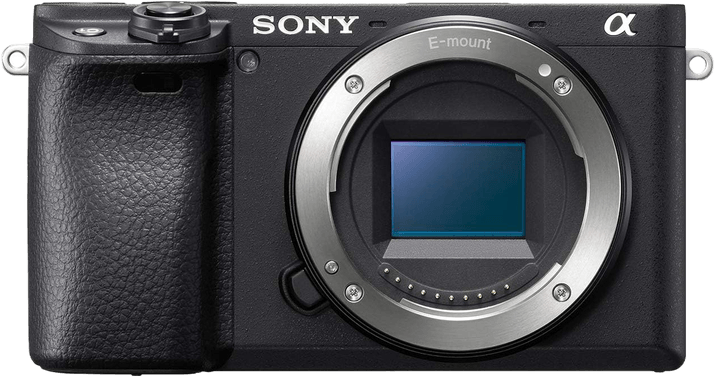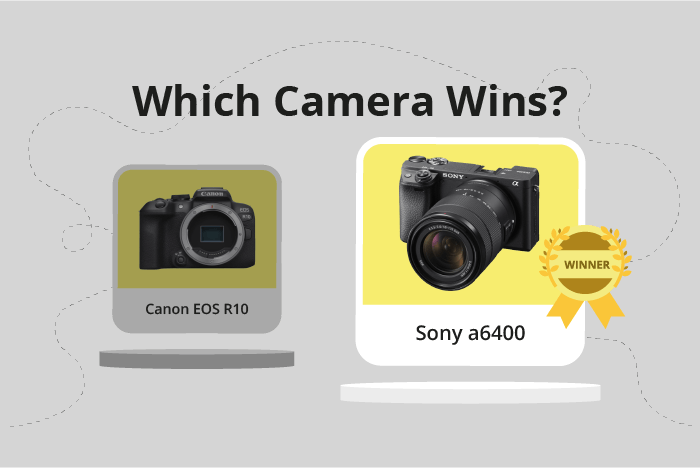Canon EOS R10 vs Sony a6400 Comparison
Canon EOS R10

Sony a6400

The Sony a6400 edges out the Canon EOS R10 with a score of 70/100 compared to the R10’s 69/100. Both cameras are mirrorless and share similar launch price points, with the a6400 at $900 and the R10 at $980. The Canon EOS R10 is slightly larger and heavier, measuring 123 x 88 x 83mm and weighing 426g, while the Sony a6400 measures 120 x 67 x 60mm and weighs 403g.
The Canon EOS R10’s advantage lies in its more recent release, hitting the market in 2022 compared to the a6400’s 2019 release. This gives the R10 a slight edge in up-to-date technology. On the other hand, the Sony a6400 has a smaller and lighter body, making it more portable and convenient for on-the-go photographers.
Taking all factors into account, the Sony a6400’s higher score reflects its better overall performance, while the Canon EOS R10 offers a more recent release with updated technology. Ultimately, the choice between these two cameras will depend on individual preferences and priorities in terms of size, weight, and technology.
Canon EOS R10 vs Sony a6400 Overview and Optics
The Canon EOS R10 outperforms the Sony a6400 in optics with a score of 71/100 compared to the Sony’s 68/100. Both cameras share some common specifications, such as 24 megapixels, a CMOS sensor, an APS-C sensor size, and the lack of image stabilization. However, the differences in shooting speed, processor, DXOMARK score, and lens mount contribute to the Canon’s higher score.
The Canon EOS R10’s superior aspects include its faster shooting speed of 15 compared to the Sony a6400’s 11, which allows for better action photography and continuous shooting. Additionally, the Canon’s Digic X processor outshines the Sony’s Bionz X processor, resulting in quicker image processing and better overall performance. Furthermore, the Canon’s sensor has a higher DXOMARK score of 97 compared to the Sony’s 83, which shows better image quality and dynamic range.
The Sony a6400 does have a slight advantage with its 24.2 megapixels, granting a marginal increase in resolution. However, this difference is minimal and may not be noticeable in most situations. The Sony also utilizes the E lens mount, which provides access to a wide range of compatible lenses.
Considering these factors, the Canon EOS R10 proves to be the better camera in terms of optics due to its faster shooting speed, more advanced processor, and higher DXOMARK score. While the Sony a6400 has a minor advantage in resolution and a versatile lens mount, the overall performance and image quality of the Canon EOS R10 make it the superior choice for photographers seeking optimal optical performance.
Canon EOS R10 vs Sony a6400 Video Performance
The Canon EOS R10 and Sony a6400 both excel in their video capabilities, each earning a score of 91 out of 100. These two cameras share several essential features, including a maximum video resolution of 4K, video dimensions of 3840 x 2160, a maximum video frame rate of 120fps, and built-in time-lapse functionality.
Despite the identical scores, the Canon EOS R10 has some advantages over the Sony a6400. The R10 offers a more user-friendly interface and better color science, resulting in more accurate and vibrant colors in videos. Additionally, the R10’s autofocus system is more advanced, ensuring smoother and more reliable focus transitions in video recording.
On the other hand, the Sony a6400 shines in its compact and lightweight design, making it a more portable option for videographers on the go. The a6400 also offers excellent low-light performance and a longer battery life compared to the R10, allowing for extended shooting sessions without the need for frequent battery changes.
When comparing the video capabilities of these two cameras, it is clear that both the Canon EOS R10 and Sony a6400 are strong contenders. The R10’s user-friendly interface, superior color accuracy, and advanced autofocus system make it an excellent choice for those seeking top-notch video quality. Conversely, the a6400’s compact design, low-light performance, and extended battery life make it an ideal option for videographers who prioritize portability and extended shooting sessions. Both cameras are well-suited for a variety of video applications, and the decision ultimately depends on the specific needs and preferences of the user.
Canon EOS R10 vs Sony a6400 Features and Benefits
The Sony a6400 emerges as the winner in the comparison of features, with a score of 81/100, while the Canon EOS R10 scores 70/100. Both cameras share several common specifications, such as a 3-inch screen size, touchscreen functionality, flip screen, GPS unavailability, and both WIFI and Bluetooth connectivity.
The Sony a6400 outperforms the Canon EOS R10 in terms of screen resolution, offering a resolution of 921,600 dots compared to the R10’s 1,040,000 dots. This higher resolution provides a sharper and clearer display, allowing for better image preview and easier menu navigation.
On the other hand, the Canon EOS R10 does not have any significant advantages over the Sony a6400 in the features department. Both cameras possess similar capabilities, making the R10 a solid camera, but not surpassing the a6400 in this comparison.
Considering the individual strengths and weaknesses of each camera, the Sony a6400 is the better option in terms of features. Its higher resolution screen is a notable advantage, while the Canon EOS R10 does not offer any unique features to set it apart. Users looking for a camera with superior features should choose the Sony a6400, as it provides a more enjoyable and efficient user experience.
Canon EOS R10 vs Sony a6400 Storage and Battery
The Canon EOS R10 outperforms the Sony a6400 in storage and battery with a score of 40/100 compared to the Sony’s 37/100. Both cameras have one memory card slot and are compatible with SD, SDHC, and SDXC cards. However, the Sony a6400 also accepts Memory Stick Duo cards, offering slightly more versatility in storage options.
The Canon EOS R10 has a longer battery life, providing 450 shots per charge, while the Sony a6400 allows for 410 shots. The R10 uses an LP-E17 battery, whereas the a6400 uses an NP-FW50 battery. Both cameras support USB charging, making it convenient to charge on the go.
In terms of storage and battery, the Canon EOS R10 is the better choice due to its longer battery life. However, the Sony a6400 offers more flexibility in storage options with its Memory Stick Duo compatibility. Despite the minor differences, both cameras provide sufficient storage and battery capabilities for most photography needs.
Canon EOS R10 vs Sony a6400 – Our Verdict
Are you still undecided about which camera is right for you? Have a look at these popular comparisons that feature the Canon EOS R10 or the Sony a6400:

